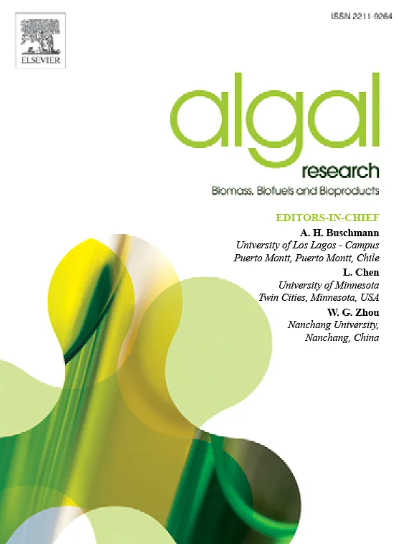Preliminary assessment of the antioxidant, anti-inflammatory, antidiabetic, and anti-carcinogenic attributes of Australian red seaweeds
IF 4.6
2区 生物学
Q1 BIOTECHNOLOGY & APPLIED MICROBIOLOGY
Algal Research-Biomass Biofuels and Bioproducts
Pub Date : 2025-03-18
DOI:10.1016/j.algal.2025.104005
引用次数: 0
Abstract
Red seaweeds contain an assortment of valuable phytochemical; however, while their pharmaceutical and therapeutic potential has been previously recognized, many aspects of their bioactive properties remain underexplored, especially among the Australian species. An ultrasonic-assisted extraction method was used to obtain polyphenol-rich extracts from thirteen Australian red seaweeds. Antioxidant activity and anti-inflammatory potential, assessed through assays such as urease inhibition and nitric oxide scavenging, as well as anti-diabetic capacity through α-amylase and α-glucosidase inhibition, were evaluated. Rhodophyllis sp. demonstrated the greatest antioxidant capacity with relative antioxidant capacity index score of 1.43, while Crouania attenuata exhibited superior antidiabetic effects through α-glucosidase and α-amylase inhibition. Notable anti-inflammatory potential was observed in Plocamium and Asparagopsis samples, with A. armata excelling in protease inhibition. Moreover, LC-ESI-QTOF-MS/MS analysis of the extracts tentatively identified 26 polyphenols, indicating the rich bioactive profile of these marine resources. The in vitro assays and phenolic composition highlight the considerable biological potential of Australian Rhodophyta, emphasizing the need for further exploration of these red seaweeds as promising candidates for therapeutic and pharmaceutical applications.

求助全文
约1分钟内获得全文
求助全文
来源期刊

Algal Research-Biomass Biofuels and Bioproducts
BIOTECHNOLOGY & APPLIED MICROBIOLOGY-
CiteScore
9.40
自引率
7.80%
发文量
332
期刊介绍:
Algal Research is an international phycology journal covering all areas of emerging technologies in algae biology, biomass production, cultivation, harvesting, extraction, bioproducts, biorefinery, engineering, and econometrics. Algae is defined to include cyanobacteria, microalgae, and protists and symbionts of interest in biotechnology. The journal publishes original research and reviews for the following scope: algal biology, including but not exclusive to: phylogeny, biodiversity, molecular traits, metabolic regulation, and genetic engineering, algal cultivation, e.g. phototrophic systems, heterotrophic systems, and mixotrophic systems, algal harvesting and extraction systems, biotechnology to convert algal biomass and components into biofuels and bioproducts, e.g., nutraceuticals, pharmaceuticals, animal feed, plastics, etc. algal products and their economic assessment
 求助内容:
求助内容: 应助结果提醒方式:
应助结果提醒方式:


